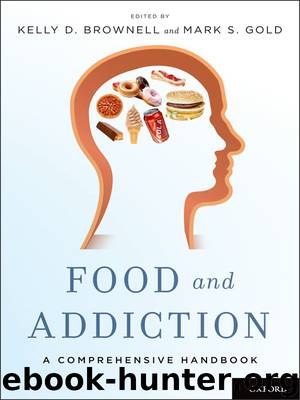Food and Addiction: A Comprehensive Handbook by Kelly D. Brownell & Mark S. Gold

Author:Kelly D. Brownell & Mark S. Gold [Brownell, Kelly D. & Gold, Mark S.]
Language: eng
Format: epub
ISBN: 9780199738168
Publisher: Oxford University Press, USA
Published: 2012-08-30T00:00:00+00:00
MEASUREMENT OF LIKING AND WANTING IN HUMANS
While liking and wanting cannot be directly measured, as with all psychological constructs, they can be operationalized. Fortunately there are many different ways that this might be accomplished. In research in nonhuman animals, liking has previously been operationalized by counting the frequency of positive and negative behavioral reactions to the taste of food. These reactions are thought to be universal expressions of affect because some of them can also be observed in primates and human infants.9 However, in older children and adults, facial reactions to tastes are less reliable, making them unsuitable as objective measures. Most commonly, liking for food is assessed explicitly by subjective psychological tools, including Likert scales, Labelled Magnitude scales,10 and Visual Analogue scales. Questions such as “How palatable is this food?” “How pleasant is the taste of this food?” and “How much do you like this food now?” are often used. Explicit forms of wanting can also be captured using subjective scales. Questions such as “How strong is your desire to eat this food?” “How much do you want this food?” or questions relating to how much effort one would go to in order to obtain a food have all been employed in previous studies. These tools are limited by the accuracy of self-reporting and methodological issues such as “end avoidance” and social desirability. However, if used carefully, they can be quite sensitive to even subtle experimental manipulations, and they frequently predict ingestive behavior.
In contrast to explicit forms of liking and wanting, implicit wanting concerns the core motivational aspects of reward-seeking behavior. Therefore, measures that reflect motivational responses to food and food-related cues can be said to contain at least an element of wanting. The more spontaneous the response, the closer that behavior is likely to reflect the core process of wanting without contamination from subjective processes. Importantly, wanting may not be adequately captured by the nonspecific desire for food in general. Wanting implies a target with a direction, not just a force.
Download
This site does not store any files on its server. We only index and link to content provided by other sites. Please contact the content providers to delete copyright contents if any and email us, we'll remove relevant links or contents immediately.
| Administration & Medicine Economics | Allied Health Professions |
| Basic Sciences | Dentistry |
| History | Medical Informatics |
| Medicine | Nursing |
| Pharmacology | Psychology |
| Research | Veterinary Medicine |
The Art of Thinking Clearly by Rolf Dobelli(10142)
The 5 Love Languages: The Secret to Love That Lasts by Gary Chapman(9518)
Mindhunter: Inside the FBI's Elite Serial Crime Unit by John E. Douglas & Mark Olshaker(9106)
Becoming Supernatural by Dr. Joe Dispenza(8040)
The Road Less Traveled by M. Scott Peck(7475)
Nudge - Improving Decisions about Health, Wealth, and Happiness by Thaler Sunstein(7460)
Mastermind: How to Think Like Sherlock Holmes by Maria Konnikova(7164)
Enlightenment Now: The Case for Reason, Science, Humanism, and Progress by Steven Pinker(7084)
Win Bigly by Scott Adams(7033)
The Way of Zen by Alan W. Watts(6452)
Factfulness: Ten Reasons We're Wrong About the World – and Why Things Are Better Than You Think by Hans Rosling(4629)
The State of Affairs by Esther Perel(4588)
Gerald's Game by Stephen King(4515)
Man's Search for Meaning by Viktor Frankl(4357)
The Confidence Code by Katty Kay(4158)
Thinking in Bets by Annie Duke(4121)
Hidden Persuasion: 33 psychological influence techniques in advertising by Marc Andrews & Matthijs van Leeuwen & Rick van Baaren(3416)
The Healing Self by Deepak Chopra(3405)
The Worm at the Core by Sheldon Solomon(3397)
